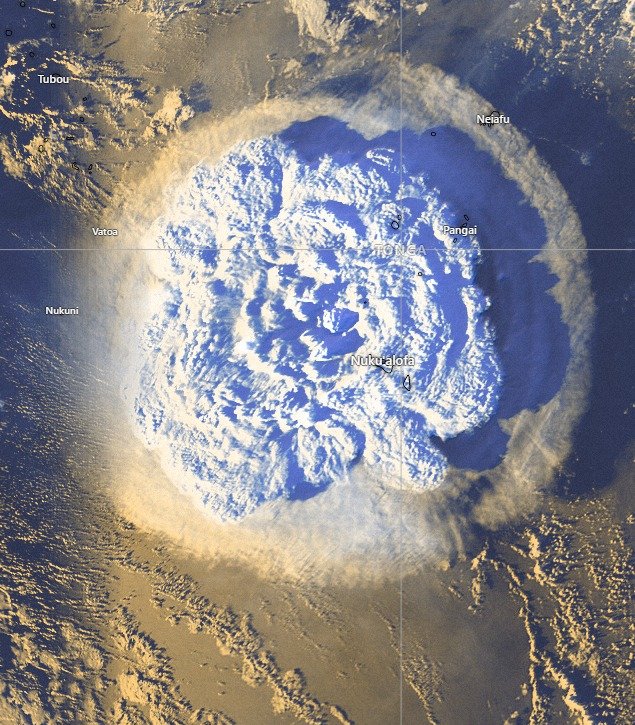The Sunshine Coast was included in a tsunami warning for Australia’s east coast, with people told to “to leave the water and move away from the immediate water’s edge”.
The warning on Sunday morning was issued after an underwater volcano erupted off Tonga, sending large waves crashing ashore on the island kingdom and triggering tsunami alerts across parts of the Pacific.
It was cancelled Sunday afternoon, but meteorologists advised unusual waves could still impact beaches.
The giant eruption of the Hunga-Tonga-Hunga-Ha’apai volcano on Saturday, which was heard across the Pacific and as far as the USA, triggered a tsunami in Tonga.
Local media on the island chain reported a downpour of ash, the flooding of properties and disruptions to phone and power connections.
Online videos show cars rushing to escape an incoming wave, water surging through homes and unsuspecting beachgoers getting thrashed.
Tsunami videos out of Tonga 🇹🇴 this afternoon following the Volcano Eruption. pic.twitter.com/JTIcEdbpGe
— Jese Tuisinu (@JTuisinu) January 15, 2022
The Bureau of Meteorology’s warning includes Queensland, NSW, Victoria and Tasmania and Lord Howe, Norfolk and Macquarie islands.
In Queensland the marine warning is in place for Sandy Cape to Point Danger including the Fraser Island coast, Sunshine Coast waters, Moreton Bay and Gold Coast waters.
“While evacuations are not necessary for marine warning zones, people in these areas are advised to leave the water and move away from the immediate water’s edge.”
The BOM statement said tsunami waves are more powerful than the same size beach waves.
“There will be many waves and the first wave may not be the largest.”
The bureau said a tsunami wave height of 1.27 metres was observed on Norfolk Island at 9pm AEDT and an 82cm wave was registered on the Gold Coast at 10.54pm AEDT on Saturday.
Countries around the Pacific were also on alert, with the southern Japanese island of Chichijima recording a 75cm wave at 1am AEDT.
The bureau earlier detected a 1.19m wave in Nuku’alofa, Tonga’s capital.
1.14.2021: Large volcanic eruption near Tonga (Hunga Tonga-Hunga Ha'apai volcano) today as seen from outer space. Shown on visible imagery using the Himawari satellite. #hiwx #tsunami #earthquake pic.twitter.com/zOTj6Qu1Wv
— NWSHonolulu (@NWSHonolulu) January 15, 2022
Authorities across the Pacific, including in Samoa, Fiji and New Zealand, issued tsunami alerts, warning people to stay away from coastal areas due to the possibility of strong and unusual currents and unpredictable surges.
“People in or near the sea should move out of the water, off beaches and shore areas and away from harbours, rivers and estuaries,” the New Zealand National Emergency Management Agency warned.
The volcano is located 65km from Tonga’s capital and about 2000 kilometres northeast of New Zealand.
We are continuing to monitor the #tsunami event after a volcanic eruption near #Tonga. Land threat warning still current for Lord Howe & Norfolk Is, marine threat warning still current for parts of Qld, NSW, Vic & Tas. Will be in place for several hours. https://t.co/4vdBUsHiKf pic.twitter.com/wOxBaMZK4y
— Bureau of Meteorology, Australia (@BOM_au) January 15, 2022
Fiji issued a tsunami warning, urging residents to avoid the shorelines “due to strong currents and dangerous waves”.
Jese Tuisinu, a television reporter at Fiji One, posted a video on Twitter showing large waves crashing ashore, with people trying to flee in their cars.
“It is literally dark in parts of Tonga and people are rushing to safety following the eruption,” he said.
An undersea volcano eruption sent large tsunami waves to the Pacific nation of Tonga, forcing people to rush to higher ground. pic.twitter.com/2rbiQl2QrZ
— DW News (@dwnews) January 15, 2022
Residents of American Samoa were alerted to a tsunami warning by local broadcasters as well as church bells that rang territory-wide as an outdoor siren warning system was out of service.
As night fell, there were no reports of any damage and the US-based Pacific Tsunami Warning Center cancelled the alert.
The volcano was erupting intermittently in late December but Friday’s eruption was about seven times more powerful than the previous eruption, Tonga Geological Services said.
with reporting from AP and Reuters.
-with AAP





